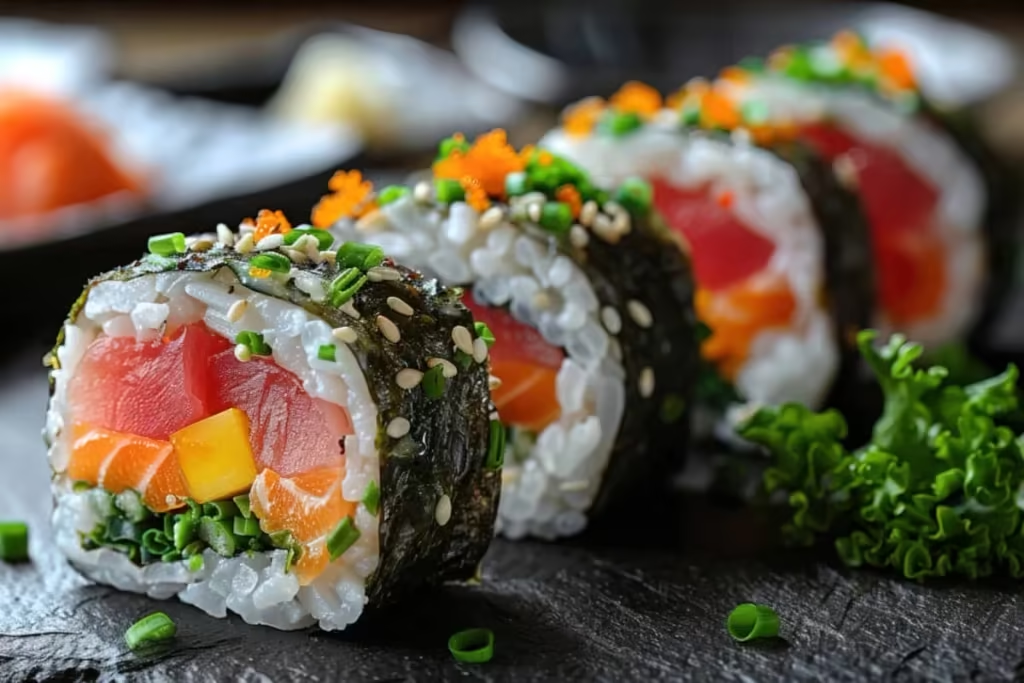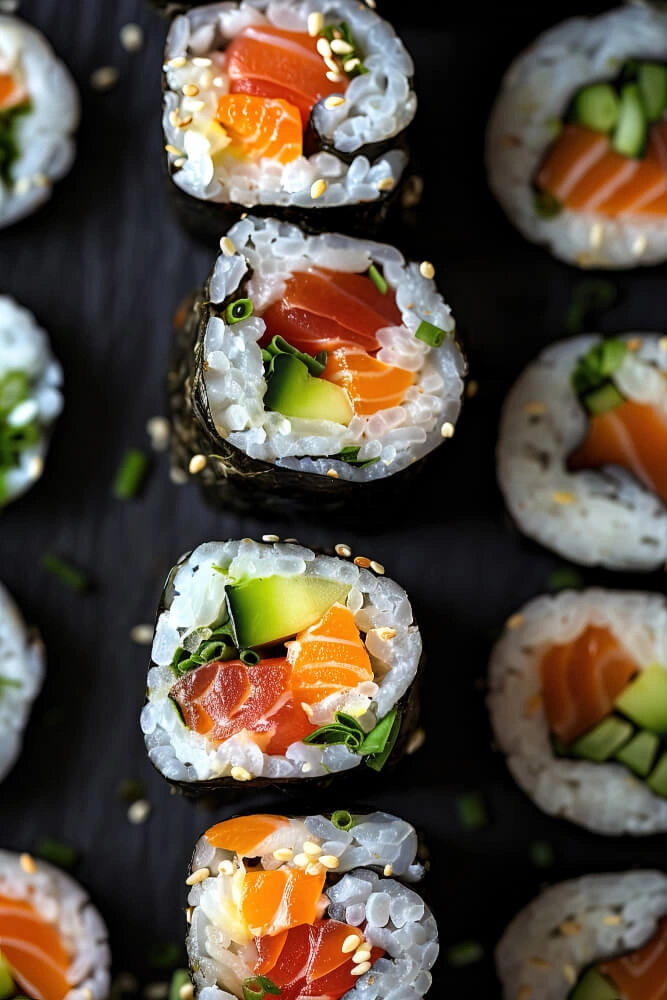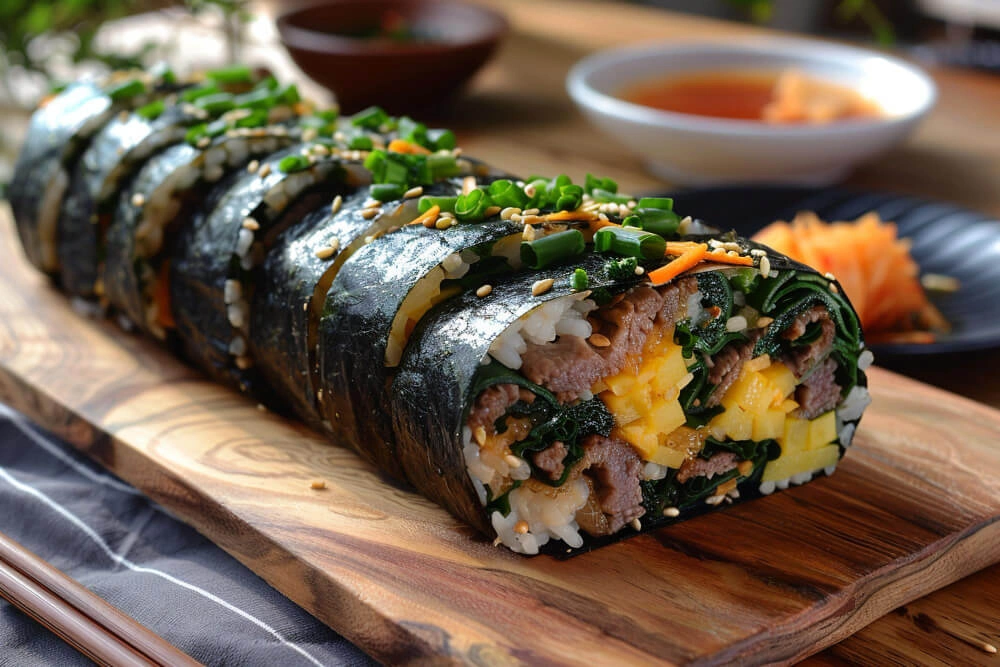
Introduction
Kimbap (김밥) is one of Korea’s most popular and cherished dishes, enjoyed by people of all ages. Often compared to Japanese sushi rolls, kimbap stands out with its unique flavors, ingredients, and cultural significance. This dish consists of rice, vegetables, and proteins wrapped in seaweed (gim) and is commonly eaten as a convenient, portable meal.
What makes kimbap so special is its versatility. It can be filled with a variety of ingredients, from classic egg, pickled radish, and beef to modern variations with cheese, tuna, or spicy kimchi. Whether prepared for school lunches, picnics, or street food stalls, kimbap remains a staple in Korean cuisine.
To fully appreciate kimbap, it’s important to explore its origins and historical evolution. While it shares similarities with Japanese sushi rolls, kimbap has developed into a distinct dish with its own identity and flavors.
The History of Kimbap
Origins: The Influence of Japanese Sushi Rolls
The origins of kimbap can be traced back to Japanese norimaki (sushi rolls), introduced to Korea during Japan’s colonial rule (1910–1945). Norimaki consists of vinegared rice, fish, and vegetables wrapped in seaweed, a preparation method that influenced the early versions of kimbap.
However, as kimbap evolved in Korea, it took on distinct characteristics:
- Instead of vinegared rice, Koreans use sesame oil and salt to season the rice, giving it a more savory and aromatic flavor.
- Traditional kimbap fillings are often cooked or pickled rather than raw, reflecting Korean culinary preferences.
- Kimbap is often packed for outdoor meals such as school lunches, picnics, or road trips, making it a convenient and hearty dish.
How Kimbap Became a Staple in Korean Cuisine
Over time, kimbap became deeply ingrained in Korean culture, adapting to local ingredients and traditions. By the mid-20th century, kimbap was widely prepared at home and sold in street markets, making it an accessible and beloved dish.
Several factors contributed to its popularity:
- Affordability – Kimbap is an inexpensive and filling meal, making it a common choice for students and workers.
- Convenience – It is easy to carry and eat on the go, making it ideal for picnics, road trips, and lunchboxes.
- Endless Variations – From classic beef kimbap to modern versions with cheese or spicy tuna, kimbap can be customized to suit different tastes.
- Cultural Significance – Kimbap is often associated with family gatherings, school outings, and celebrations, creating a strong emotional connection for many Koreans.
Essential Ingredients for the Perfect Kimbap
Choosing the Right Type of Rice: Short-Grain vs. Medium-Grain
Rice is the foundation of kimbap, and using the right type ensures the perfect texture and flavor.
- Short-Grain Rice (Best Choice) – Sticky, slightly chewy, and holds together well when rolling. This is the preferred option for traditional kimbap.
- Medium-Grain Rice – Can be used if short-grain rice is unavailable, but it is slightly less sticky.
- Avoid Long-Grain Rice – It is too dry and does not hold together well for rolling.
Nori (Seaweed): Quality Matters
The seaweed (nori or gim, 김) used in kimbap plays an important role in holding everything together while adding a savory, slightly crisp texture.
- Use high-quality roasted seaweed – It should be thin but sturdy enough to hold the fillings.
- Avoid overly brittle or thick nori, as it may crack while rolling or overpower the flavors.
- Toasting the seaweed lightly before rolling enhances its aroma and crispiness.
Classic Fillings: Egg, Carrot, Spinach, Pickled Radish, and Protein
Kimbap fillings add color, texture, and layers of flavor. The classic combination includes:
- Egg – Cooked into a thin omelet, sliced into strips for a soft and slightly rich filling.
- Carrot – Lightly stir-fried for a sweet, slightly crunchy texture.
- Spinach – Blanched and seasoned with sesame oil and salt for a nutty, fresh taste.
- Pickled Radish (Danmuji, 단무지) – Provides a signature sweet and tangy crunch.
- Protein – Common options include:
- Beef (Bulgogi) – Marinated and stir-fried for a savory, umami-rich bite.
- Fish Cake (Eomuk, 어묵) – Adds a slightly chewy texture with a mildly sweet taste.
- Ham or Imitation Crab – Quick and easy options for a classic kimbap flavor.
Step-by-Step Recipe for Homemade Kimbap
Cooking and Seasoning the Rice with Sesame Oil and Salt
Ingredients for the Rice:
- 2 cups short-grain rice
- 2 ½ cups water
- 1 tbsp sesame oil
- ½ tsp salt
Instructions:
- Rinse the rice under cold water until the water runs clear. Drain well.
- Cook the rice using a rice cooker or stovetop. Let it rest for 10 minutes after cooking.
- Transfer the rice to a large bowl and gently mix in sesame oil and salt while the rice is still warm. Avoid overmixing to keep the texture fluffy.
- Cover with a damp cloth to keep it from drying out.
Preparing the Fillings: Blanching, Stir-Frying, and Slicing
Ingredients for Fillings:
- 2 eggs, beaten
- 1 small carrot, julienned
- 1 bunch spinach, washed
- 4 strips pickled radish (danmuji)
- ½ cup cooked bulgogi or ham
Instructions:
- Eggs – Heat a nonstick pan, pour in beaten eggs, and cook a thin omelet. Let it cool, then slice into thin strips.
- Carrot – Stir-fry julienned carrot in a little sesame oil for 1-2 minutes until slightly soft.
- Spinach – Blanch in boiling water for 30 seconds, then drain and squeeze out excess water. Season with a pinch of salt and sesame oil.
- Protein – Cook bulgogi beef or ham and slice into thin strips.
- Pickled Radish – Cut into long, thin strips if needed.

Rolling the Kimbap: Achieving the Perfect Cylindrical Shape
Instructions:
- Place a sheet of nori (shiny side down) on a bamboo sushi mat (gimbap mat).
- Spread a thin, even layer of rice over two-thirds of the nori, leaving about 1 inch uncovered at the top.
- Arrange fillings horizontally in the center of the rice.
- Roll firmly using the bamboo mat, applying gentle but steady pressure to shape a tight cylinder.
- Dab a little water or sesame oil on the edge of the nori to help seal the roll.
Slicing and Serving for the Best Presentation
Instructions:
- Lightly brush a sharp knife with sesame oil to prevent sticking.
- Slice the kimbap into ½-inch thick pieces using a smooth, downward motion.
- Arrange on a plate and garnish with sesame seeds for extra flavor.
Expert Tips for Achieving the Best Kimbap
How to Keep Kimbap from Falling Apart
One of the most common challenges when making kimbap is ensuring that the rolls stay intact. Here’s how to keep them from falling apart:
- Use the right rice – Short-grain rice is naturally sticky and helps hold the roll together. Avoid using long-grain rice, which is too dry.
- Don’t overfill – Too many ingredients make the roll difficult to seal properly. Stick to a balanced amount of fillings.
- Press firmly while rolling – Use a bamboo mat (gimbap mat) to apply even pressure while rolling. A tight roll prevents ingredients from shifting.
- Seal the nori properly – Dab a little water or sesame oil along the edge of the seaweed before rolling to help it stick.
- Let the roll sit before slicing – Allow the kimbap roll to rest for a few minutes before cutting, which helps it set and stay firm.
The Best Knife Techniques for Clean Slices
A sharp, well-prepared knife is essential for slicing kimbap neatly without squashing it.
- Use a sharp knife – A dull knife will crush the roll rather than cut cleanly.
- Lightly oil the knife – Brush the blade with a little sesame oil or dip it in water before cutting to prevent sticking.
- Use a smooth slicing motion – Instead of pressing down hard, slice through the roll in a gentle, back-and-forth motion to maintain its shape.
- Cut in even pieces – Aim for ½-inch thick slices for the best presentation and bite-sized enjoyment.
Common Mistakes and How to Avoid Them
Even experienced cooks can run into issues when making kimbaps. Here are some common mistakes and how to fix them:
- Mistake: The rice is too dry or too mushy
- Solution: Use the right water-to-rice ratio (about 1:1.25 for short-grain rice). Let the rice rest for 10 minutes after cooking before seasoning.
- Mistake: The nori (seaweed) is tearing or too soft
- Solution: Use high-quality roasted nori. Avoid overfilling the roll, and roll quickly before moisture from the rice softens the seaweed too much.
- Mistake: The roll is too loose and falls apart when cutting
- Solution: Roll tightly and evenly, ensuring even pressure from end to end. Let the roll sit for a few minutes before slicing.
- Mistake: The kimbap dries out quickly
- Solution: If not eating immediately, cover kimbap with plastic wrap or a damp paper towel to maintain freshness. Brush the surface lightly with sesame oil to keep the seaweed from becoming brittle.
Creative Variations of Kimbap
Once you’ve mastered classic kimbaps, experiment with different fillings to suit your taste. Here are some delicious variations to try:
Tuna Mayo Kimbap (Chamchi Kimbap)
A popular variation, tuna mayo kimbap is creamy, flavorful, and easy to prepare.
How to Make It:
- Mix 1 can of tuna with 2 tbsp of mayonnaise and ½ tsp of salt.
- Spread the tuna mixture evenly over the rice.
- Add sliced cucumber, pickled radish, and egg strips for extra texture.
Bulgogi Beef Kimbap
For a heartier, protein-packed roll, bulgogi beef kimbaps are a must-try.
How to Make It:
- Marinate ½ cup of thinly sliced beef in:
- 1 tbsp soy sauce
- 1 tsp sugar
- 1 tsp sesame oil
- 1 minced garlic clove
- A pinch of black pepper
- Stir-fry the marinated beef until cooked.
- Assemble with carrots, pickled radish, and egg strips for a balanced bite.
Spicy Kimchi Kimbap
For those who love a bit of heat, spicy kimchi kimbap is a bold and flavorful option.
How to Make It:
- Chop ½ cup of well-fermented kimchi and mix with 1 tsp sesame oil and 1 tsp gochujang (Korean red chili paste).
- Spread the spicy kimchi over the rice.
- Add cooked egg, cucumber, and a bit of seasoned ground beef or tofu.
Vegan and Gluten-Free Kimbap Options
For a plant-based version, kimbaps can be made with simple, nutritious ingredients while still maintaining its signature taste and texture.
How to Make It:
- Replace egg and meat with marinated tofu strips or sautéed mushrooms.
- Use traditional fillings like carrot, spinach, pickled radish, and avocado.
- Ensure the soy sauce used in seasonings is gluten-free, or use tamari instead.
- Brush the finished roll with extra sesame oil for added richness.
Best Dipping Sauces and Side Dishes for Kimbap
Classic Kimbap Dipping Sauce
Unlike sushi, which is often dipped in soy sauce, traditional kimbap is usually enjoyed without a dipping sauce because it is already well-seasoned with sesame oil and salt. However, if you prefer extra flavor, you can serve it with a light, savory dipping sauce.
Simple Kimbap Dipping Sauce Recipe:
- 2 tbsp soy sauce
- 1 tsp sesame oil
- ½ tsp honey or sugar
- ½ tsp rice vinegar (optional, for a tangy twist)
- ¼ tsp gochugaru (Korean red pepper flakes) or a dash of sriracha for spice
- ½ tsp toasted sesame seeds
Instructions:
- Mix all the ingredients in a small bowl until well combined.
- Serve as a light dipping sauce for kimbap, adjusting sweetness or spice to taste.
Kimchi, Pickles, and Korean Side Dishes (Banchan)
Kimbap pairs perfectly with traditional Korean side dishes, adding contrast in flavors and textures.
Best Side Dishes for Kimbap:
- Kimchi (김치) – Fermented spicy cabbage or radish that provides a tangy, slightly spicy contrast to kimbap.
- Danmuji (단무지) – Bright yellow pickled radish, often already inside kimbap, but extra slices on the side enhance the meal.
- Oi Muchim (오이무침) – Spicy Korean cucumber salad, offering a refreshing, crunchy complement.
- Korean Fish Cakes (어묵볶음, Eomuk Bokkeum) – Stir-fried fish cakes with soy sauce and sesame oil for a savory pairing.
- Japchae (잡채) – Sweet and savory stir-fried glass noodles with vegetables, a great side for kimbap.
- Gyeran Mari (계란말이) – Korean-style rolled omelet, a soft and slightly sweet egg dish that pairs well with the flavors of kimbap.

How to Store and Keep Kimbap Fresh
Best Refrigeration Practices to Prevent Hardening
One of the biggest challenges with storing kimbap is that the rice tends to dry out in the fridge, making the rolls hard and less enjoyable.
How to Store Kimbap in the Refrigerator:
- Wrap each kimbap roll tightly in plastic wrap to prevent air exposure.
- Place the wrapped rolls in an airtight container to maintain freshness.
- Store in the refrigerator for up to 24 hours. After this time, the texture may change, and the seaweed may become chewy.
- Avoid refrigerating for too long, as cold temperatures make the rice tough and dry.
How to Reheat Kimbap Without Drying It Out
Best Reheating Methods:
1. Pan-Fried Kimbap (Mayak Kimbap Style) – Best for Reviving Texture
- Lightly brush a pan with sesame oil and heat on medium-low heat.
- Place the kimbap slices in the pan and lightly toast them for 1-2 minutes per side, until the seaweed crisps up slightly and the rice softens.
- Serve warm for a different but delicious take on kimbap.
2. Steaming Method – Best for Keeping Kimbap Soft
- Wrap the kimbap loosely in a damp paper towel and place it in a steamer for 1-2 minutes.
- The moisture will soften the rice without making the seaweed too soggy.
3. Microwave Method – Quickest Option
- Wrap the kimbap in a damp paper towel to help prevent dryness.
- Microwave for 10-15 seconds, just until slightly warm.
- Be careful not to overheat, as this can make the seaweed chewy.
FAQs
Can I make kimbap ahead of time for lunch?
Yes, kimbap is a great make-ahead meal, but it’s best when eaten fresh. If making kimbap in advance for lunch, follow these tips to keep it soft and fresh:
- Wrap each roll tightly in plastic wrap to prevent the rice from drying out.
- Brush the outer layer with a small amount of sesame oil to keep the seaweed from becoming tough.
- Store at room temperature for up to 4 hours, but avoid refrigerating for too long, as the rice can harden.
- For best results, make Korean rice roll, in the morning and eat it the same day.
What’s the difference between sushi and kimbap?
Although they look similar, kimbap and sushi have distinct flavors, ingredients, and preparation methods.
| Feature | Kimbap (Korean) | Sushi (Japanese) |
|---|---|---|
| Rice Seasoning | Sesame oil & salt | Vinegar & sugar |
| Fillings | Cooked, pickled, or fresh ingredients (beef, fish cake, egg, vegetables) | Often raw fish, seafood, or fresh vegetables |
| Flavor Profile | Savory, nutty, slightly sweet | Mild, slightly tangy |
| Eating Style | Usually eaten without dipping sauce | Served with soy sauce, wasabi, and pickled ginger |
How do I keep the seaweed from becoming too chewy?
Seaweed (nori or gim) can become chewy if exposed to moisture for too long. Here’s how to keep it crisp:
- Use high-quality roasted seaweed that is thin but sturdy.
- Assemble and eat kimbap fresh before the seaweed absorbs too much moisture from the rice.
- Lightly toast the seaweed over low heat before rolling to enhance its crispiness.
- Avoid refrigerating Korean rice roll, for too long—cold temperatures make seaweed tough and rubbery.
- Brush the roll with a bit of sesame oil after slicing to keep the outer layer flavorful and soft.
Can I make kimbap without a bamboo rolling mat?
Yes! While a bamboo mat (gimbap mat) makes rolling easier, you can still make Korean rice roll,without one.
Alternative Methods:
- Plastic Wrap Method – Lay a sheet of plastic wrap on a clean surface, place the seaweed and rice on top, then roll tightly using the plastic wrap for support.
- Parchment Paper Method – Similar to the plastic wrap technique but with parchment paper, which provides better grip.
- By Hand – If comfortable, roll the kimbap carefully with your fingers, applying firm, even pressure.
Conclusion
Kimbap is more than just a Korean rice roll—it is a versatile, flavorful, and deeply cultural dish that can be enjoyed in countless ways. Whether made with classic fillings like bulgogi and pickled radish or modern variations like spicy kimchi or tuna mayo, kimbap is a dish that suits every taste and occasion.
By mastering the right rolling techniques, choosing fresh ingredients, and using expert storage methods, you can make perfect homemade kimbap that stays delicious and visually appealing. Pairing it with savory dipping sauces, banchan side dishes, or a warm cup of soup enhances the overall experience, making kimbap an ideal meal for lunch, picnics, or a quick snack.
Viral Tuna Salad: 5 Bold Reasons Matthew McConaughey’s Recipe Wins
Healthy Homemade Chicken Mortadella
Chicken Mortadella changed my deli game forever. I used to stare at processed meat…
The BEST Taco Pasta
When I’m short on time and need to get a satisfying dinner on…
Classic German Kartoffelpuffer Recipe (Authentic, Crispy & Easy to Make)
Easy Butter Pecan Cookies Recipe
There’s something undeniably comforting about the scent of buttery, nutty cookies wafting from…
Perfect Strawberry Cheesecake Recipe
If there’s one dessert that’s guaranteed to silence a lively room, it’s this…






